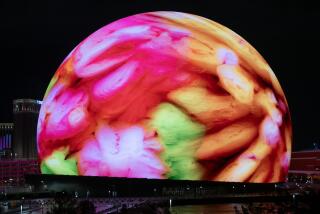BOOK REVIEW / SCIENCE : To Sum It All Up, It’s Fun With Fractals : CHAOS IN WONDERLAND: Visual Adventures in a Fractal World <i> by Clifford A. Pickover</i> ; St. Martin’s Press $29.95, 302 pages
- Share via
Since 1990, Clifford Pickover has published nearly a book a year in which he stretches the limits of computers, art and thought.
First was “Computers, Pattern, Chaos and Beauty: Graphics From an Unseen World.” Then came “Computers and the Imagination: Visual Adventures Beyond the Edge.” Then “Mazes for the Mind: Computers and the Unexpected” (all from St. Martin’s Press).
His latest, “Chaos in Wonderland: Visual Adventures in a Fractal World,” continues this remarkable series, and, like its predecessors, it is full of imagination and breathtaking pictures. There is a black-and-white graphic on practically every page. The color plates are mesmerizing.
To Pickover, computers are not about word processing, spreadsheets or the information superhighway. Computers are primarily visual machines. They let you create and explore images whose beauty captures the intersection of mathematics, nature and art.
Pickover’s ostensible topic is fractals, which were discovered 20 years ago by Benoit Mandelbrot, who realized that much as we like to draw straight lines and round circles, the real world has very few of either. Coastlines are hopelessly irregular, as are the shapes of mountains and clouds.
Pickover, a computer scientist at IBM’s Thomas J. Watson Research Center in Yorktown Heights, N.Y., is no linear thinker. His book is a melange of mathematics, computer graphics and chaos theory built around a thin science fiction story that is meant to hold it all together.
The story involves a race of beings called Latoocarfians, who live on Ganymede, Jupiter’s largest moon. These Latoocarfians, it turns out, spend their days dreaming up beautiful mathematical images. Social status in their society “is not achieved through political prowess or financial fritinancy” but through “thoughts of mathematical beauty. The more beautiful the pattern, the greater the individual’s prestige and position.”
This crowd is ruled by one Yars Kotheck, who teaches “that all the miseries in life are due to selfishness and greedy desire. There is no social order, no security, no happiness, no peace, no kingship or righteous leadership unless Latoocarfians lose themselves to the study of mathematically chaotic patterns.”
Science fiction, indeed.
The first part of the book is about the patterns they come up with and how they do it along with tips for programming your computer to do it, too.
The second part of the book presents a series of Indiana Jones-like adventures by two scientists, Garth and Kalinda, as they make their way across Ganymede in search of the Latoocarfians. They encounter fractal spiders and use a fractal sword to slay a never-ending string of creatures that are out to kill them.
Pickover’s imagination for dreaming up these beasts is apparently limitless. At one point our heroes meet up with a group called the Water Beings, who exist in a pool of water. “They have no physical being except for the chemicals in the liquid. Their molecules are mind.” When Garth scoops up some of the water in a jar, he wonders whether there is any consciousness in it.
The third part of the book offers technical information along with such diversions as the Fractal Fantasy Game, the Fractal Sponge Game and the Fractal Triangle Game. There are also odds and ends that don’t seem to be related at all, such as Pickover’s list of “The 100 Strangest Mathematical Titles Ever Published” and “The 15 Most Famous Transcendental Numbers.” He even answers mail he received from readers of his previous books.
“Chaos in Wonderland” is liberally festooned with epigrams from philosophers, scientists, historians, psychologists, writers and the like.
The sum total of all of this--the exposition, the science fiction, the games, lists, speculations, quotations and art--makes an intriguing and entertaining whole.
Pickover is fascinated by the visual power of computers. He believes that computer-generated art enables people to see structures and perceive connections that they otherwise could not. This book is an effort to help them do that.
One complaint: Since the publisher put so much effort into making the book beautiful, it is astounding that it contains so many typographical errors. And by the way, fritinancy ? I had to look in the Oxford English Dictionary for that one. It means twittering.
More to Read
Sign up for our Book Club newsletter
Get the latest news, events and more from the Los Angeles Times Book Club, and help us get L.A. reading and talking.
You may occasionally receive promotional content from the Los Angeles Times.








